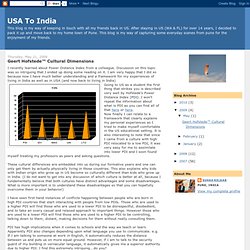

Geert Hofstede™ Cultural Dimensions. I recently learned about Power Distance Index from a colleague.

Discussion on this topic was so intriguing that I ended up doing some reading on it. I am very happy that I did so because now I have much better understanding and a framework for my experiences of living in India as well as in USA (and now back to living in India) Going to US as a student the first thing that strikes you is described very well by Hofstede's Power Distance Index (PDI). I won't repeat the information about what is PDI as you can find all of that here or here.Now finally I can relate to a framework that clearly explains my personal experiences as I tried to make myself comfortable in the US educational setting. 06_Going_Local_in_India. LinkClick. India Cultural Analysis Using Hofstede's Cultural Dimension Analysis & Schein Modelling by Mikael Thakur.
Hofstede studies india. Culture.india. India Business Etiquette, Vital Manners, Cross Cultural Communication, and Geert Hofstede Analysis. The Geert Hofstede analysis for India shows a large power distance society and all other measures are relatively moderate.

This would be indicative of the fact that India is in the midst of change. The traditional caste systems has been outlawed, however the large power distance score indicates that the attitudes still remain. India has Power Distance (PDI) as the highest Hofstede Dimension for the culture, with a ranking of 77 compared to a world average of 56.5. This Power Distance score for India indicates a high level of inequality of power and wealth within the society.
This condition is not necessarily subverted upon the population, but rather accepted by the population as a cultural norm.